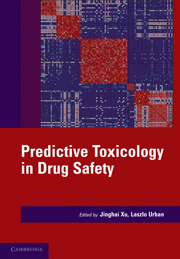Book contents
- Frontmatter
- Contents
- Contributors
- Prologue – Predictive toxicology: a new chapter in drug safety evaluation
- PREDICTIVE TOXICOLOGY IN DRUG SAFETY
- I SPECIFIC AREAS OF PREDICTIVE TOXICOLOGY
- II INTEGRATED APPROACHES OF PREDICTIVE TOXICOLOGY
- 10 Integrated approaches to lead optimization: improving the therapeutic index
- 11 Predictive toxicology approaches for small molecule oncology drugs
- 12 Mechanism-based toxicity studies for drug development
- 13 Fish embryos as alternative models for drug safety evaluation
- 14 The role of genetically modified mouse models in predictive toxicology
- 15 Toxicogenomic and pathway analysis
- 16 Drug safety biomarkers
- 17 Application of TK/PD modeling in predicting dose-limiting toxicity
- 18 Prediction of therapeutic index of antibody-based therapeutics: mathematical modeling approaches
- 19 Vaccine toxicology: nonclinical predictive strategies
- Epilogue
- Index
- Plate section
- References
11 - Predictive toxicology approaches for small molecule oncology drugs
from II - INTEGRATED APPROACHES OF PREDICTIVE TOXICOLOGY
Published online by Cambridge University Press: 06 December 2010
- Frontmatter
- Contents
- Contributors
- Prologue – Predictive toxicology: a new chapter in drug safety evaluation
- PREDICTIVE TOXICOLOGY IN DRUG SAFETY
- I SPECIFIC AREAS OF PREDICTIVE TOXICOLOGY
- II INTEGRATED APPROACHES OF PREDICTIVE TOXICOLOGY
- 10 Integrated approaches to lead optimization: improving the therapeutic index
- 11 Predictive toxicology approaches for small molecule oncology drugs
- 12 Mechanism-based toxicity studies for drug development
- 13 Fish embryos as alternative models for drug safety evaluation
- 14 The role of genetically modified mouse models in predictive toxicology
- 15 Toxicogenomic and pathway analysis
- 16 Drug safety biomarkers
- 17 Application of TK/PD modeling in predicting dose-limiting toxicity
- 18 Prediction of therapeutic index of antibody-based therapeutics: mathematical modeling approaches
- 19 Vaccine toxicology: nonclinical predictive strategies
- Epilogue
- Index
- Plate section
- References
Summary
CANCER AS A WORLDWIDE DISEASE
Oncology therapeutic research and development represents the greatest opportunity today for pharmaceutical companies to significantly affect morbidity and mortality in the developed world. More than 12 million new cancer cases emerged worldwide in 2007. In 2009, approximately 560,000 people were projected to die from malignancies in the United States. According to the World Cancer Center Report 2008, cancer is destined to become the leading cause of death on the planet by 2010. The number of new cancer cases per year is predicted to triple by the year 2030, which represents 20 million to 26 million new cases and 13 million to 17 million additional deaths annually. Of equal significance is the number of new drugs undergoing testing for treatment of various forms of cancer. As of April 2009, 831 drugs and vaccines were in clinical development, which is a 32 percent increase over the number of oncologic agents in development in April 2008.
This daunting unmet medical need, coupled with the rapid demise of the majority of cancer patients, requires that oncology drug development follow a much different paradigm than that used for the development of drugs for non-life-threatening diseases. The challenges of oncology drug development are underscored by the fact that phase 1 clinical trials commonly include patients with nonresponsive late-stage disease and a mean life expectancy of 3 to 5 months; patients treated with oncology drugs targeted against solid metastatic tumor disease (excluding a few cancers, such as hormone-dependent metastatic prostate cancer), typically have a mean life expectancy of only 1 to 2 years.
- Type
- Chapter
- Information
- Predictive Toxicology in Drug Safety , pp. 204 - 229Publisher: Cambridge University PressPrint publication year: 2010



